Review: Sharjah Biennial 12 - The past, the present, the possible
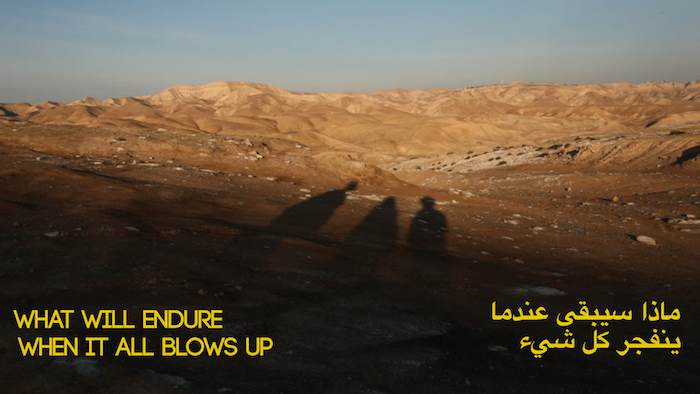
Basel Abbas and Ruanne Abou-Rahme, The Incidental Insurgents: When the fall of the dictionary leaves all words lying in the streets (P art 3) , 2015. Commissioned by Sharjah Art Foundation. Video still. Courtesy of the artists.
Sharjah Biennial 12 was on from 5th March till 5th June. I had a chance to visit it during the opening weekend and since then I visited a couple of times to see the work.
Curated by Eungie Joo with the title, "The past, the present, the possible", this year's biennial was much smaller compared to Sharjah Biennial 11 in 2013, with 51 artists participating compared to 100+ artists in 2013.
Rather than conforming to proscribed themes, works in SB12 are presented in conversation with each other. Challenging modes of participation and engagement, The past, the present, the possible invites participants and the public to reflect upon the possibilities and ambitions of Sharjah, a city and emirate still in the process of imagining itself through education, culture, religion, heritage and science.
SB12 acknowledges the centrality of the present - respecting the past, but rejecting nostalgia and the burden of history in favour of productive imaginings of the possible. These perspectives resonate with the ideas of philosopher Henri Lefebvre in his essay The Right to the City (1967), which inspired the exhibition’s title.
My first impression of the biennial during the opening week is that it was very 'inward', I didn't feel the presence of the biennial - with lots of exhibitions and installations held indoors. It didn't feel that engaged with the community and its surroundings compared to previous biennials.
I didn't see/feel the conversation between the works as not all the work really reflected upon "the possibilities and ambitions of Sharjah". Also, if Sharjah was the focus of the biennial, I wondered why there weren't more artists from the UAE invited to participate. Only three (and only male) artists from the UAE were in this biennial - Abdulla Al Saadi, Mohammed Kazem and Hassan Sharif. All three are established artists and not just in the UAE, but I couldn't help but wonder why weren't more UAE based artists included.
Having said that, there were some works in the biennial that related to Sharjah and there were some very good standalone work, regardless of the theme.
I address this in the Tea with Culture podcast below in a discussion with Wael Hattar about Sharjah Biennial 12. We also talk about some of my favourite works, which you will see listed below.
Here are my top 10 picks from Sharjah Biennial 12, the quoted descriptions are taken from the official biennial catalogue.
Abdulla Al Saadi - Al Zannouba Journey (2015)
Various media - Commissioned by Sharjah Art Foundation
I love the fact that Al Saadi travels across the UAE on foot and documents his experience. He's created work from his previous trips and this is a new addition which includes paintings, writing and video.
Al Zannoba Journey is an extension of Al Saadi’s The Watermelon Series, The Comparative Journey and most notably, The Stone Slippers / Al Zannoba (all 2013).
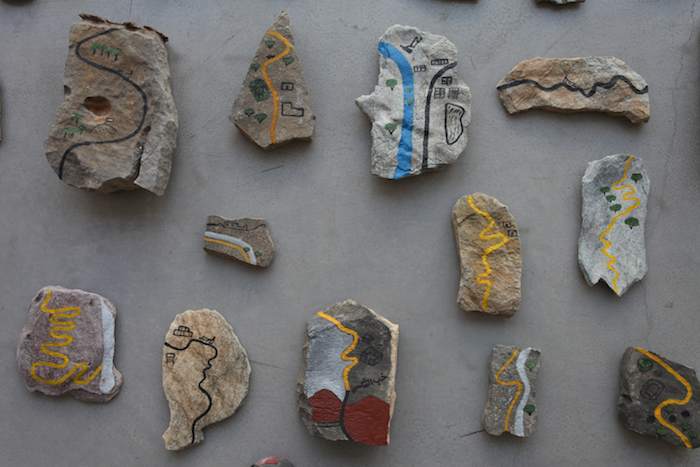
Abdullah Al Saadi, Al Zannoba Journey, 2015. Various media. Commissioned by Sharjah Art Foundation. Courtesy of the artist. Detail view , Sharjah Biennial 12. Image courtesy of Sharjah Art Foundation. Photo by Alfredo Rubio.
For this journey, Al Saadi planned to walk wearing zannoba, or slippers, made by the artist from rubber and goat skin. Following a specific route through mountain areas and villages in the eastern region of the UAE, Al Saadi attempted to remain self-sufficient, transporting his supplies and belongings in a wheelbarrow.
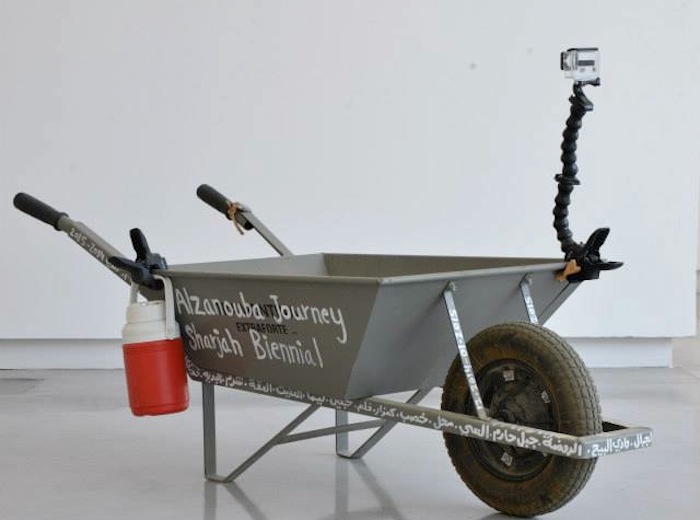
Both slippers and wheelbarrow failed him, cutting his feet and refusing to move along the steep, uneven path. But Al Saadi persevered, each limit along the way providing fuel for reflection and reconsideration.
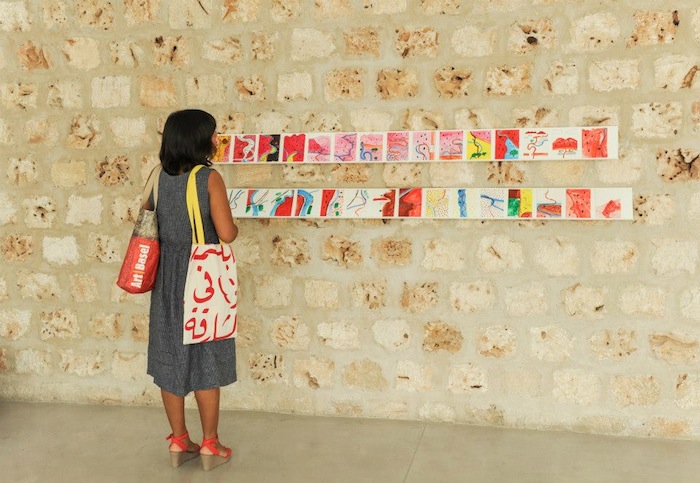
Al Saadi documented his journey in various ways, including a GoPro camera attached to the wheelbarrow, thirty-one small paintings of the landscape employing different perspectival orientations, a journal recording his daily activities and maplike paintings on stones collected while travelling. Together these elements locate the changing relationship between nature and man.
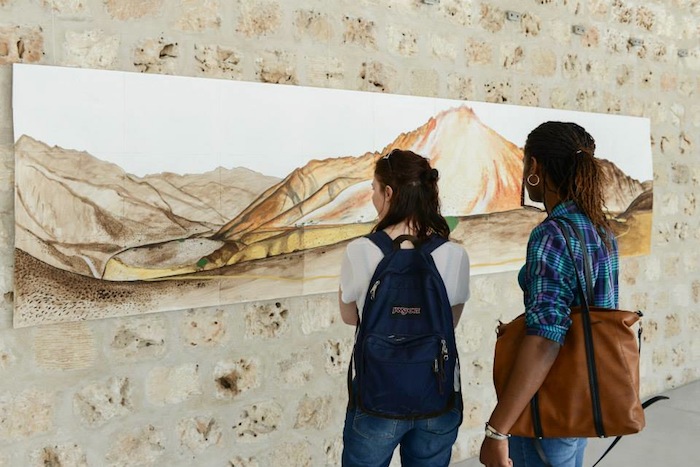
Abdulla Al Saadi - Scarecrows (2013)
Mixed media installation
Another piece by Al Saadi, this one is from 2013 that was humourous, but also addresses public space and social relations in this region.
In 2009, Abdullah Al Saadi had the opportunity to explore Brazil during a four-month residency in South America. Inspired by the thirty-eight-metre-tall Christ the Redeemer statue that reigns over Rio de Janeiro, he made Scarecrows (2013).
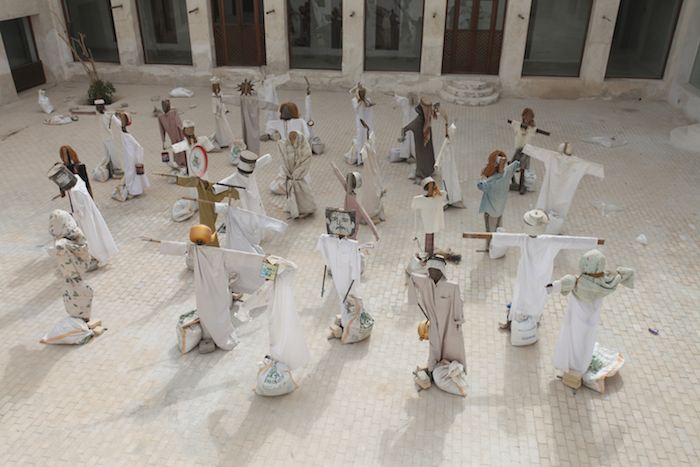
Abdullah Al Saadi, Scarecrows, 2013, Mixed-media installation. Courtesy of the art ist. Installation view, Sharjah Biennial 12. Image court esy of Sharjah Art Foundation. Photo by Alfredo Rubio.
While scarecrows are commonly used in fields to scare birds away to protect growing crops, Al Saadi’s idea was to create these figures in a decorative manner to attract the public.
Repurposing found objects, gourds and various distressed materials that reflect local culture and daily life, the artist depicts a community of both male and female scarecrows to disrupt taboos of gender, social relations and public space.
For SB12, dozens of these scarecrows are displayed in the open courtyard of Bait Al Serkal, an absurd, silent anti-monument.
Damián Ortega - Talking Wall (2015)
Wooden cast, clay, sand, gravel, hay, rocks, Styrofoam ear pieces and flexible PVC pipes - Commissioned by Sharjah Art Foundation
I really liked Talking Wall because it made me think of communication, isolation, private and public spaces.
Talking Wall continues Damián Ortega’s long engagement with architecture, informal construction and systems of communication. The work also pursues the artist’s concern with restricted areas and the boundaries that define physical and intellectual territories, particularly those that can be easily violated.
On his first visit to Sharjah, Ortega was intrigued by the walls found in the heritage area and the abandoned village at Al Khan. Constructed from fossilised coral, these walls are made to be transgressed. As a thermal filter, they allow warm air to travel through organic micro-labyrinths kept moist to promote natural ventilation and cooling.
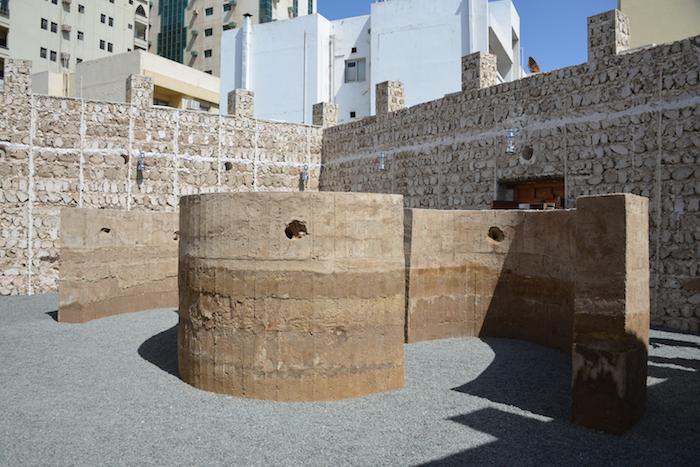
Damián Ortega, Talking Wall, 2015. Wooden cast, clay, sand, gravel, hay, rocks, Styrofoam ear pieces and flexible PVC pipes. Dimensions varia ble. Commissioned by Sharjah Art Foundation. Courtesy kurimanzutto, Mexico City and the artist. Installation view, Sharjah Biennial 12. Image courtesy of Sharjah Art Foundati on. Photo by Alfredo Rubio.
Though walls are unequivocal symbols of private property, they function as uncertain barriers, frequently penetrated by street noises, voices and weather. As suggested by Walter Benjamin’s concept of porosity, the wall as defined border between interior and exterior can evolve through spontaneous use and nature’s chaos.
The three curved structures in Talking Wall are punctuated with generous orifices connected by an invisible system of channels that transform the dense, rammed earth walls into sensitive, receptive and communicative sites.
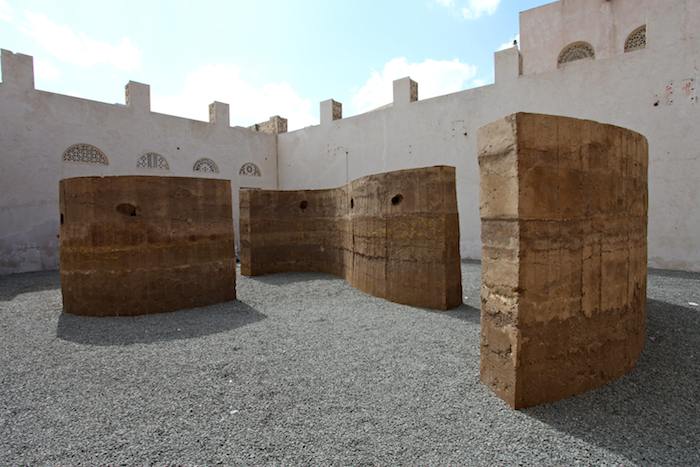
Damián Ortega, Talking Wall, 2015. Wooden cast, clay, sand, gravel, hay, rocks, Styrofoam ear pieces and flexible PVC pipes. Dimensions varia ble. Commissioned by Sharjah Art Foundation. Courtesy kurimanzutto, Mexico City and the artist. Installation view, Sharjah Biennial 12. Image courtesy of Sharjah Art Foundati on. Photo by Alfredo Rubio.
Jawshing Arthur Liou - Kora (2011-12)
Video installation, 27:54 minutes
I was in awe as soon as I stepped in the room because of the size of the screen. The film was hypnotic, about reflection, solace and the power of nature. A beautiful video piece which I hope many people got to see.
Jawshing Arthur Liou creates video installations that employ digital technology to transform representation and reality. Kora (2011–12) highlights Liou’s 2,300-kilometre expedition from Lhasa through the Tibetan Plateau, ending at Mount Everest and Mount Kailash.
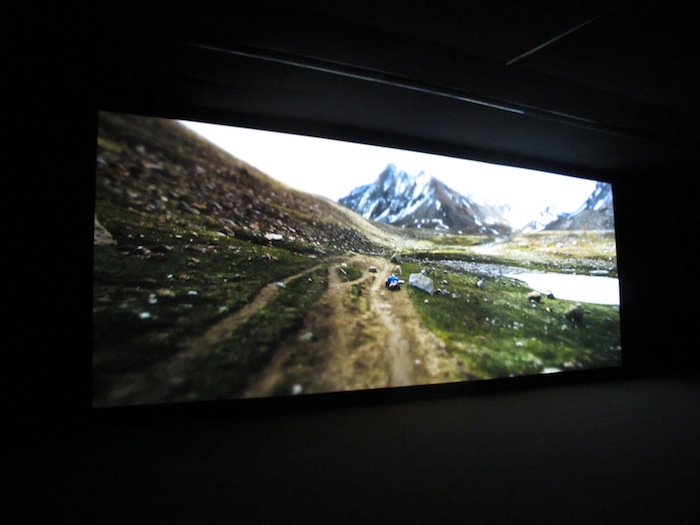
Jawshing Arthur Liou - Kora - Installation view © Hind Mezaina
The cathartic journey, which followed the passing of his daughter Vivian, included a four-day kora – a walking circumambulation – around Mount Kailash at an elevation between five and six thousand metres. The work retraces the steps of his search while presenting vast mountain landscapes, invoking a reverence for nature and space for spiritual reflection and sanctuary.
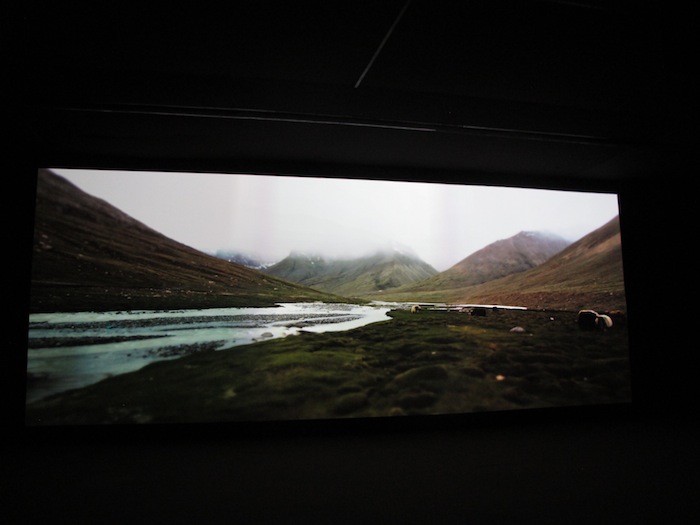
Jawshing Arthur Liou - Kora - Installation view © Hind Mezaina
Liou captured the experience of his pilgrimage on an ultra-high-definition 4K camera, and structured it with a minimalistic acoustic soundtrack. Focusing on the path ahead from a first-person perspective, the work simulates the otherworldliness of his journey, with startling, ever-changing vistas witnessed through the hallucinatory scrim of limited oxygen. Liou’s slow, mesmerizing excursion around the sacred mountain wends through a pass strewn with colourful prayer flags – evidence of the spiritual quests of thousands of pilgrims before him.
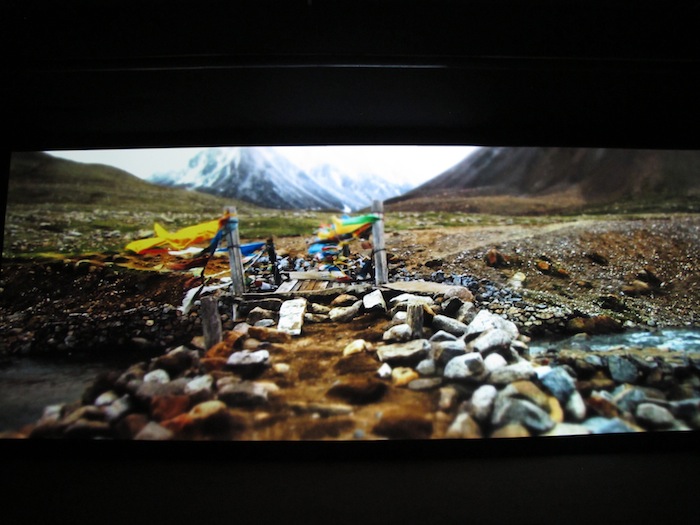
Jawshing Arthur Liou - Kora - Installation view © Hind Mezaina
Rayyane Tabet - Steel Rings (2013- )
Rolled engraved steel - 80 x 10 x 0.6 cm each
A brilliant use of space inside Sharjah Museum and a very powerful installation reflecting on the political and econimic situation in the Middle East.
A line is a construction of distance in space, time and vision. It gives a strong definition to form and position through connection and separation. The Trans-Arabian Pipe Line Company (TAPLine) was established in 1946 to build and operate a 1,213-kilometre-long, seventy-eight centimetre-wide pipeline to transport oil by land from Saudi Arabia to Lebanon through Jordan and Syria, and after 1967, through the Golan Heights.
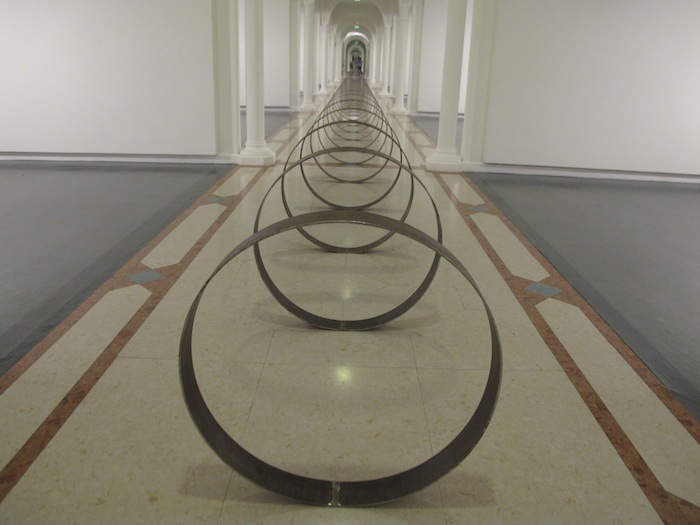
Rayyane Tabet - Steel Rings © Hind Mezaina
With this endeavour, the company conjoined three intersecting lines in an arc of history, geography and geometry. Due to the sociopolitical and geographic transformation of the region in 1983, the company was dissolved and the pipeline abandoned, its infrastructure left hidden on the land. Today it is the only physical object that crosses the borders of five countries in a region very conscious of its demarcated boundaries.
Steel Rings (2013– ), from the series The Shortest Distance Between Two Points (2007– ), is a sculpture that replicates this hidden history in ten-centimetre sections manufactured to the same diameter and thickness of the original pipeline, each engraved with the distance from the pipe's source and its corresponding geographic coordinates. Consuming an entire wing of the Sharjah Art Museum, this installation of Steel Rings represents the first sixty kilometres of the TAPLine from its origin in Saudi Arabia.
Basel Abbas & Ruanne Abou-Rahme - The Incidental Insurgents (Parts 1–3)
Mixed-media installation - Partial commission by Sharjah Art Foundation
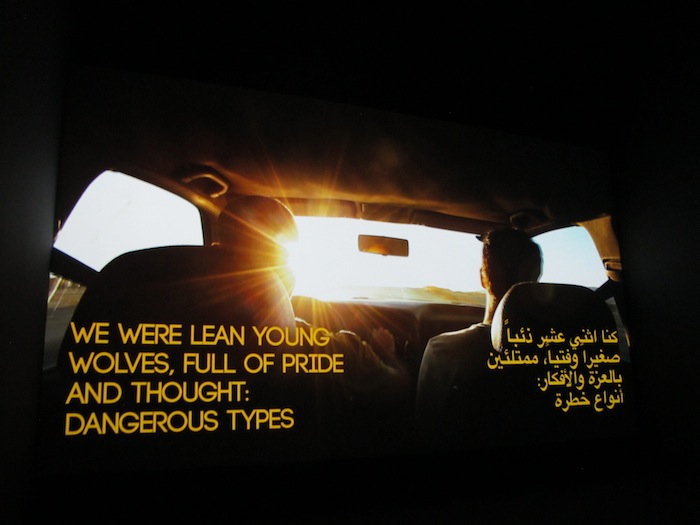
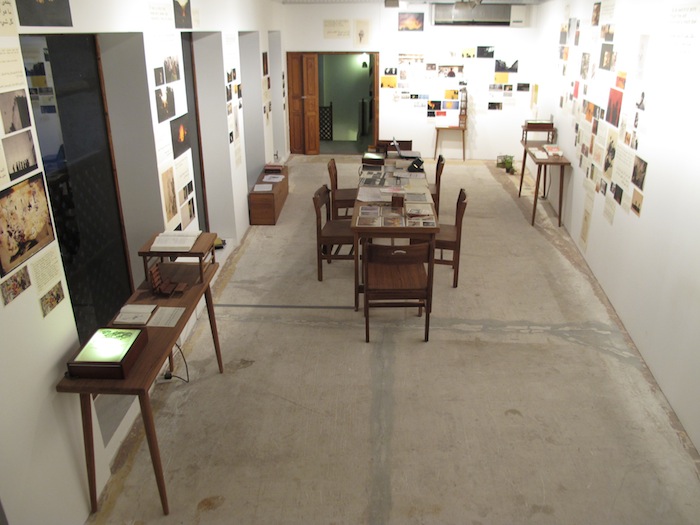
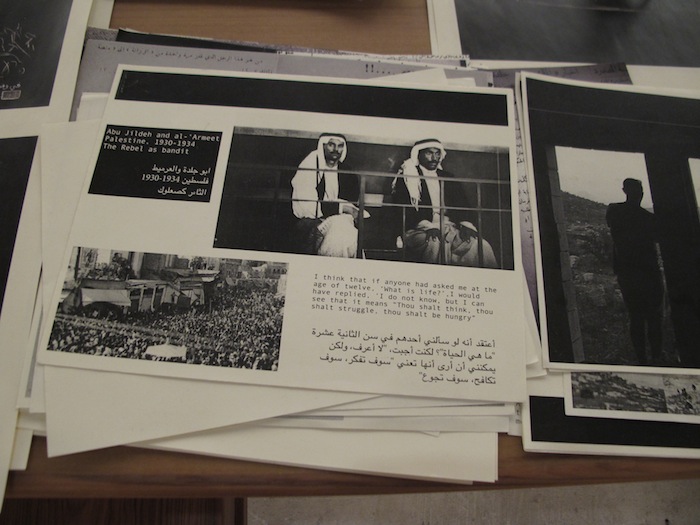
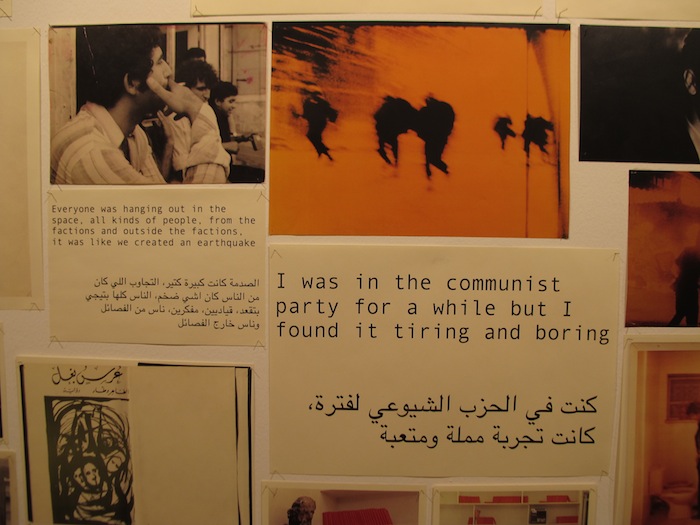
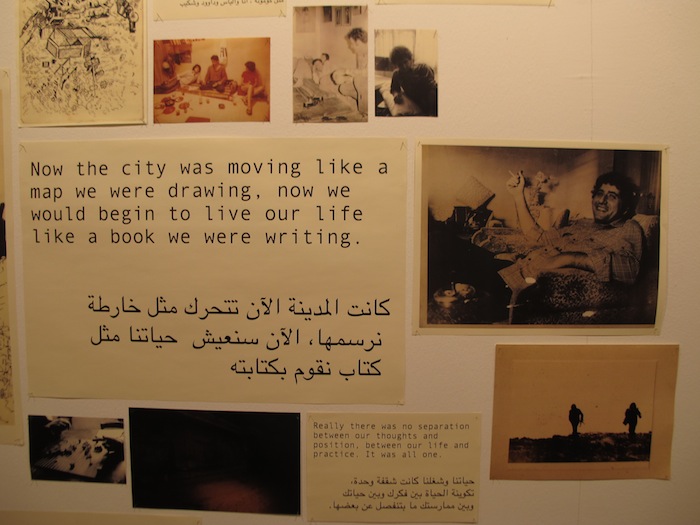
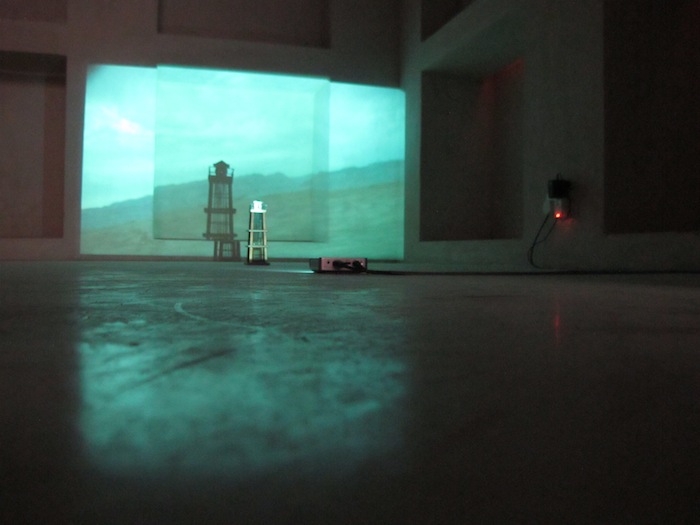
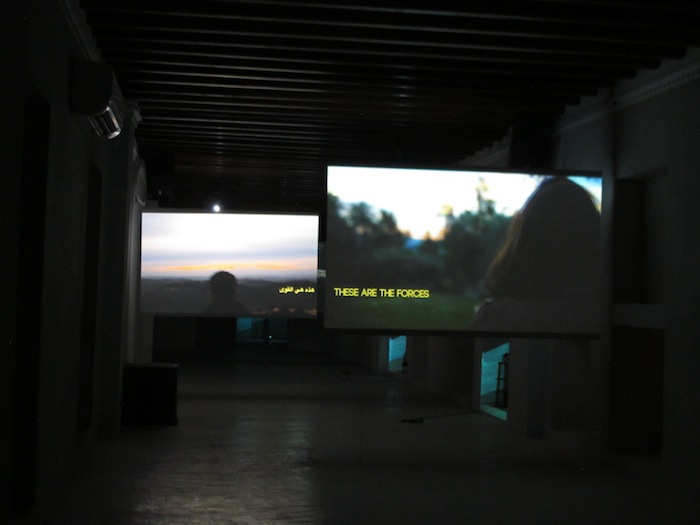
Photos © Hind Mezaina
Another impressive installation that included video and a 'studio space' that drew me in. The studio space had a lot of work to read and look at, it made me feel like I wanted to grab a seat and go through all the piles of paper and books. The three part video series were shown in two different spaces, as a viewer I felt like i was 'following' the characters who were just driving or walking forward, with thoughts and questions appearing on the screen.
A three-part installation that spatialises a contemporary search for a new political language and imaginary. The project positions the ‘incidental insurgent’ as both a foil for present deficiencies and a protagonist in the pursuit of new formations of self-determination.
In SB12, The Part about the Bandits (Part 1) (2012) and Unforgiving Years (Part 2) (2014) are presented across a screening room and in an artist’s studio turned meeting area.
In the latter, a variety of original and appropriated materials entwines an unlikely group of protagonists: the Marxist revolutionary Victor Serge, Abu Jildeh and Arameet, the bandit in Roberto Bolaño’s The Savage Detectives (1998), the publishing house Manshourat Salah El Din’ and the artists themselves.
The installation’s suspended state reflects the challenges of leveraging prior political gains in the face of current configurations of power and capital.
When the fall of the dictionary leaves all words lying in the streets (Part 3) (2015), commissioned for SB12, comprises a four-channel video installation driven by an experimental audio track.
Perhaps giving palpable form to the potential of the incidental insurgent in its myriad manifestations, Part 3 draws from reality, imagination and memory to move toward a direction that cannot be seen but feels possible.
Unnikrishnan C-Untitled (2015)
Oil, acrylic and carving on terracotta bricks - Commissioned by Sharjah Art Foundation
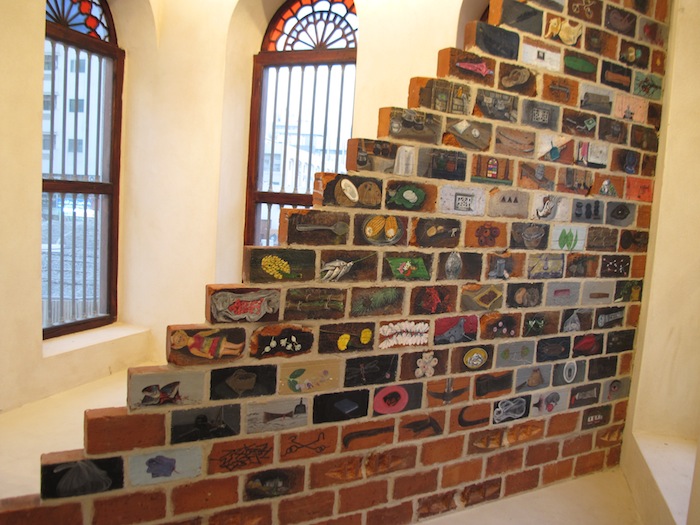
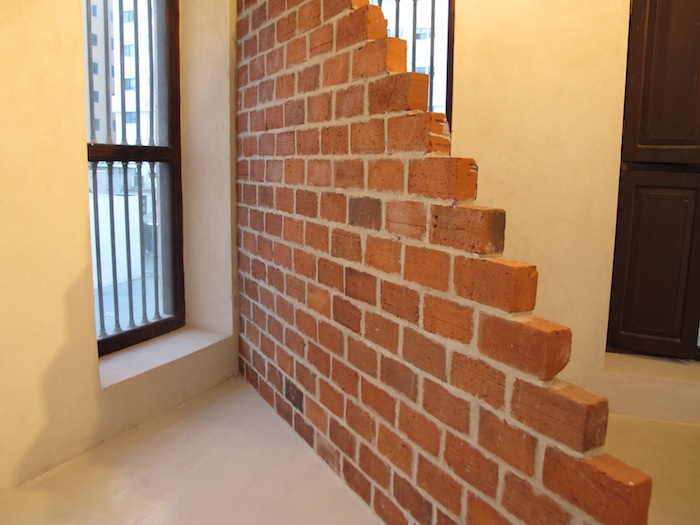
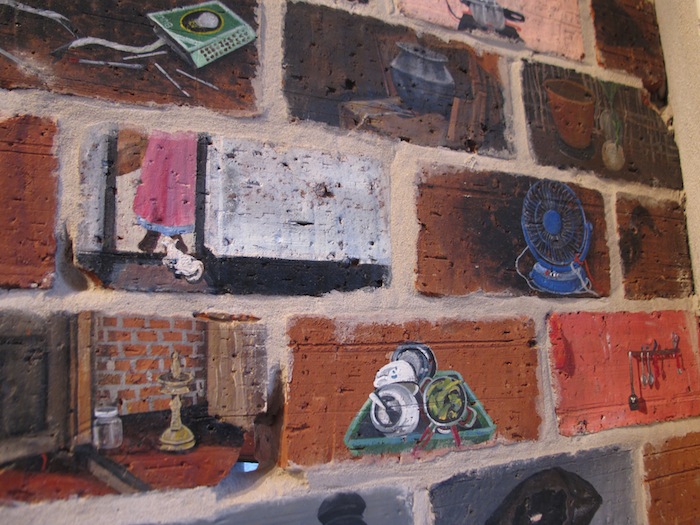
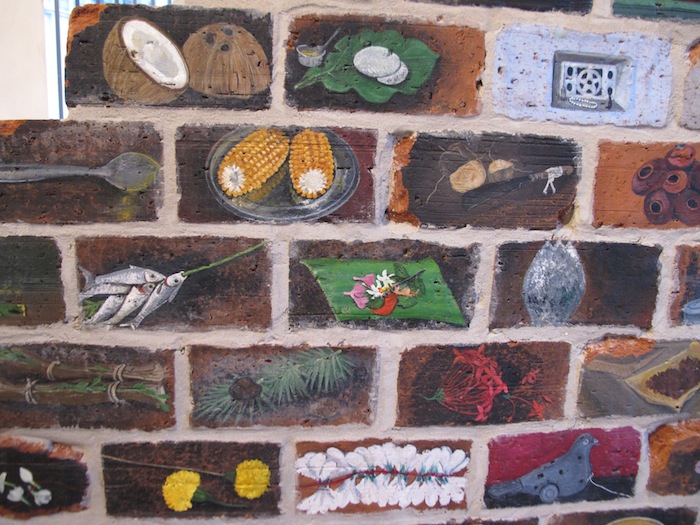
Photos © Hind Mezaina
Unnikrishnan C was born into a family traditionally engaged in basket weaving in Pezhumpara in rural Kerala. His work draws from his surroundings, especially the imagery and belief system he encountered at home.
While an art student, he started painting the terracotta bricks on the walls of his home, creating one painting a day like pages of a diary not limited to the present.
Unnikrishnan’s paintings and carvings on brick record intimate scenes of life in the city and anecdotes of his relations with people and objects. These modest vignettes reveal the artist’s urge to archive objects and ways of living that face extinction as rural Kerala sees the collapse of traditional economies centred on craft and textiles.
Untitled (2015) is a freestanding wall composed of more than three hundred painted and carved bricks that the artist has created in Pezhumpara and on site in Sharjah. Assembled as a wall dissecting the space, together these fragments suggest various structural possibilities of space and human behaviour in certain contexts.
Rheim Al Kadhi - Communications From the Field of Contact (Each Hair is a Tongue) (2015)
One of the most intimate pieces of work at the biennial, Al Kadhi created a piece made of eyelashes of sea labourers she met along Sharjah Creek.
Alkadhi’s new commission attempts to provide a framework by which to contemplate new cultural intimacies. By soliciting small pieces of peripheral vision – the eyelashes of sea labourers who work along Sharjah Creek – relationships were forged between strangers with a shared regard for the sea.
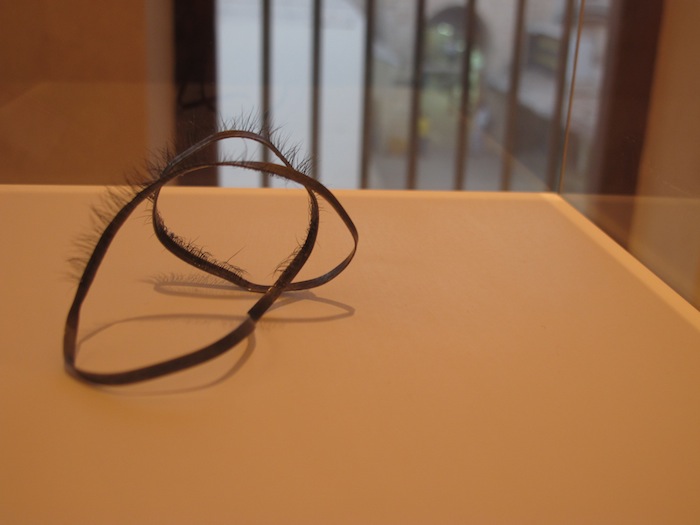
Rheim Al Kadhi - Communications From the Field of Contact (Each Hair is a Tongue) © Hind Mezaina
Through this intimate exchange, the stranger-participants navigated unfixed identities in migrating moments. In her work Alkadhi asks, ‘Within this temporary field, how close can we get to seeing differently than before?’
Asuncion Molinos - WAM (World Agriculture Museum) 2010/2015
Mixed-media installation
In her practice, Asunción Molinos Gordo questions the categories that define ‘innovation’ in mainstream discourses. She employs installation, photography, video, sound and other media to examine the rural realm and understand the value and complexity of its cultural production and the burdens that keep it invisible and marginalised, often disregarded as folkloric or mythological.
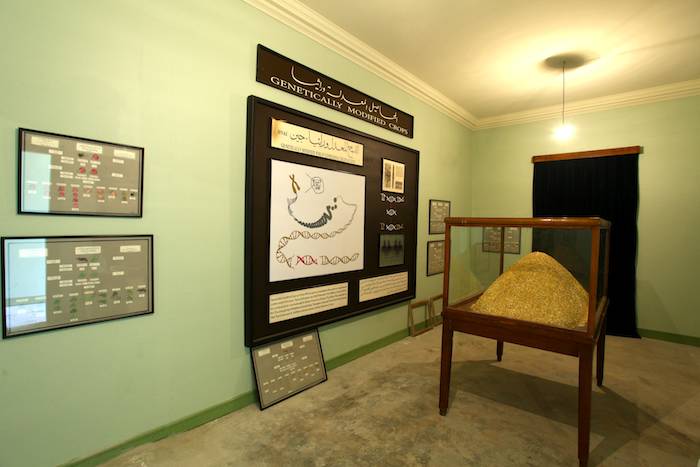
Asunción Molinos Gordo, WAM (World Agriculture Museum), 2010/2015. Mixed-media installation. Dimensions variable. Courtesy of the artist. Installation view, Sharjah Biennial 12. Image courtesy of Sharjah Art Foundation. Photo by Alfredo Rubio
WAM (World Agriculture Museum) combines parody, fiction, theatre and fair-distribution data to challenge the production of history and knowledge. The work employs the trope of the cabinet of curiosities to explore current methods of farming and food production. Influenced by the eclectic Agricultural Museum of Cairo, WAM recreates the atmosphere of the old museum and its colonial aesthetic, updated with contemporary discourse on ‘agricultural progress’ and biotechnology.
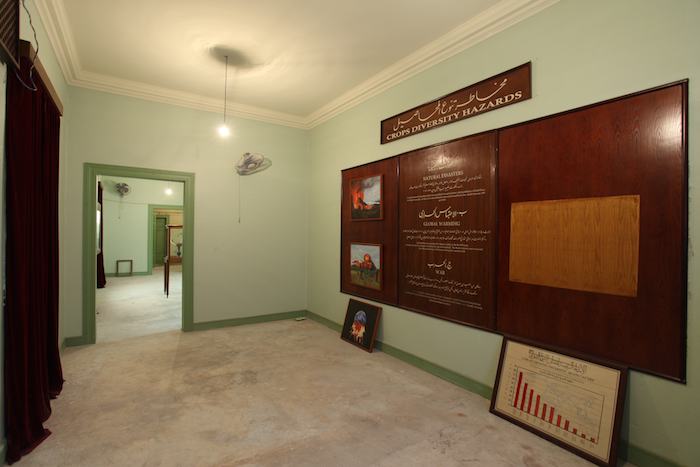
Asunción Molinos Gordo, WAM (World Agriculture Museum), 2010/2015. Mixed-media installation. Dimensions variable. Courtesy of the artist. Installation view, Sharjah Biennial 12. Image courtesy of Sharjah Art Foundation. Photo by Alfredo Rubio
Understanding the museum as a theatre stage, Molinos Gordo displays a symbolic arrangement of images, raw data and opinion in an attempt to construct an incomplete scenario that reveals inconsistencies in the hegemonic narrative around food production and introduces the issues of today’s food crisis. WAM immerses the public in a spatiotemporal illusion – a museum of the future in which the truths of our present reveal their potential obsolescence and fragility.
Michael Joo - Locale Inscribed (Walking in the desert with Eisa towards the sun, looking down) 2014-15
Intervention in existing site and silver nitrate - 20 x 27 m
Commissioned by Sharjah Art Foundation
This would be my number 1 favourite work from the biennial. I loved the aesthetics of the piece, the idea behind it and the space. It also took on different characteristics depending on the time of the day. It was bright and shiny during the day, but the space felt very sinister at night.
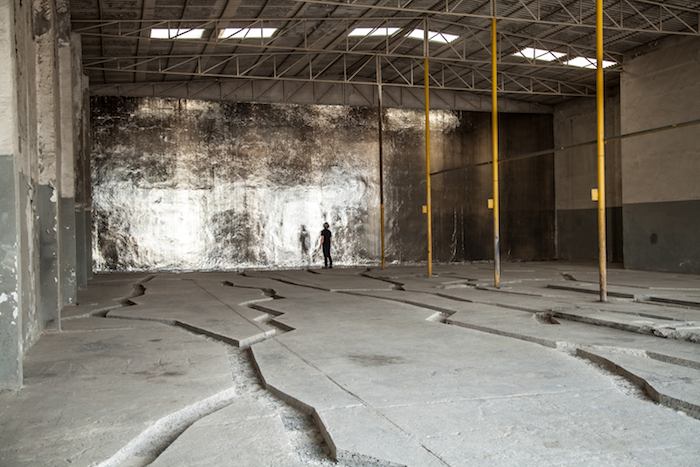
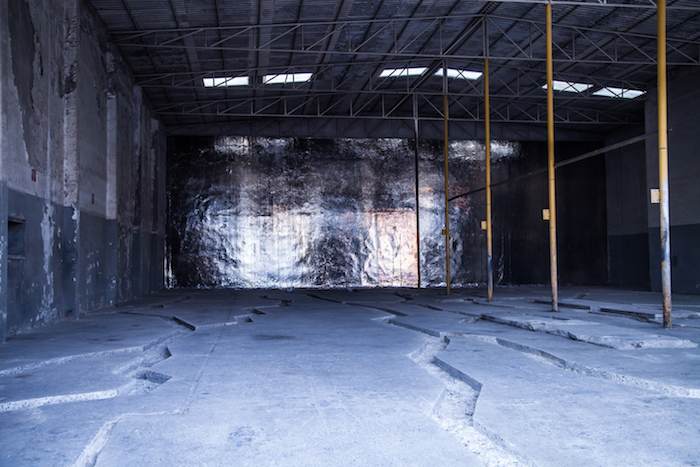
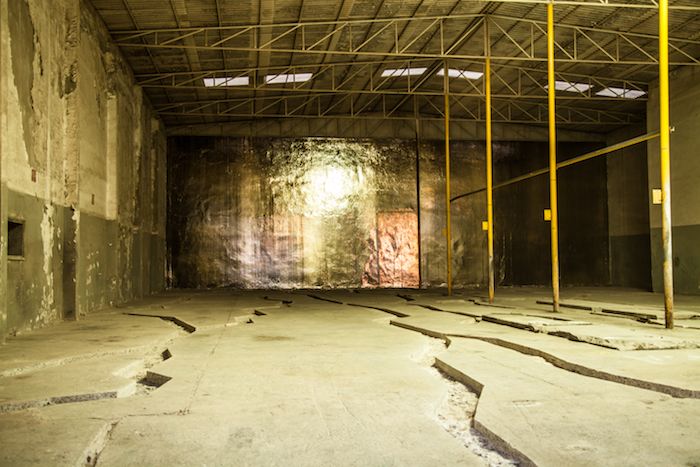
Michael Joo , Locale Inscribed (Walking in the desert with Eisa towards the sun, looking down), 2014–15. Intervention in existing site and silver n itrate. 20 x 27 m. Commissioned by Sharjah Art Foundation. Courtesy Blain|Southern Gallery, Lo ndon; Kukje Gallery, Seoul; and the artist. Installation view, Sharjah Biennial 12. Image court esy of Sharjah Art Foundation. Image courtesy of Sharjah Art Foundation. Photo by Deema Shahin
In his work, Michael Joo interrogates science and technology in conversation with the history of art. His works generate a set of questions that examine the ongoing exchange between man and natural history.
Joo developed his commission for SB12 after researching fossilised remains, ancient irrigation systems and outmoded ways of living. But the work is also deeply tied to his existing practice and long dialogue with the land art of Robert Smithson, here referenced through an obviating of process, with visible layers pointing to a conversation with time.
This work emerged from Joo’s site visits to Sharjah over the past year, which traversed various terrains to track archaeological patterns and traces of past human life through the universal act of walking – an act that bridges time and encourages deep contemplation of how early man negotiated survival, efficiency and pleasure. Joo’s site-specific work in a derelict warehouse near Port Khalid asks the public to perform the same act of walking.
As they follow excavated pathways that recall falaj water channels, a reflective surface covering the entire main wall bears witness to their movement. Seen in the silver-nitrate-mirrored surface, the visitor is at once walking towards herself, leaving the past behind, and towards an unknown future, which incorporates that abandoned past.
Here's a video interview with Michael Joo explaining the work.
Adrian Villar Rojas - Planetarium
Site-specific installation at Kalba Ice Factory - Commissioned by Sharjah Art Foundation
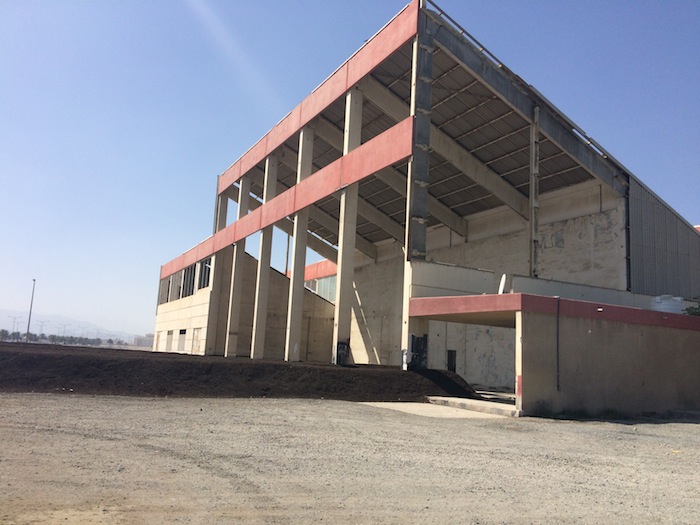

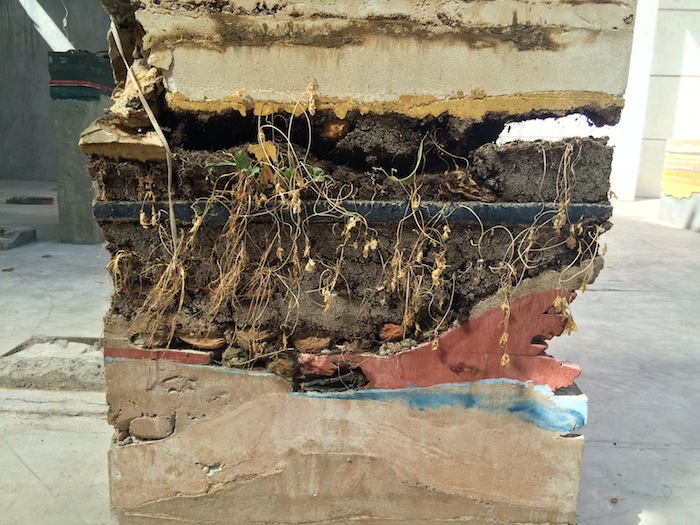
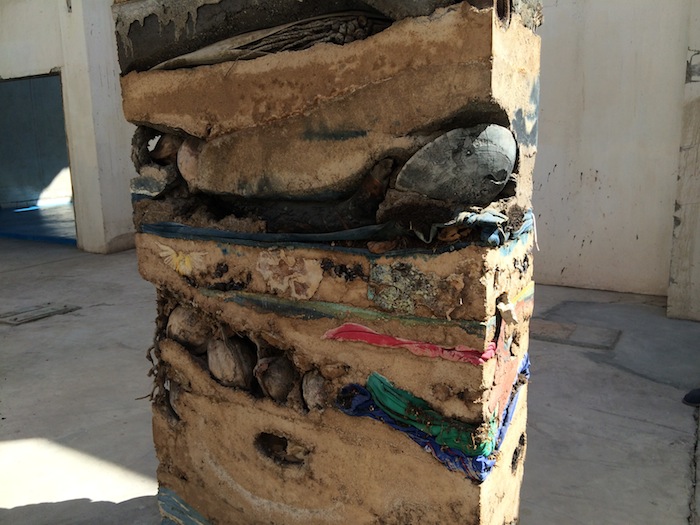
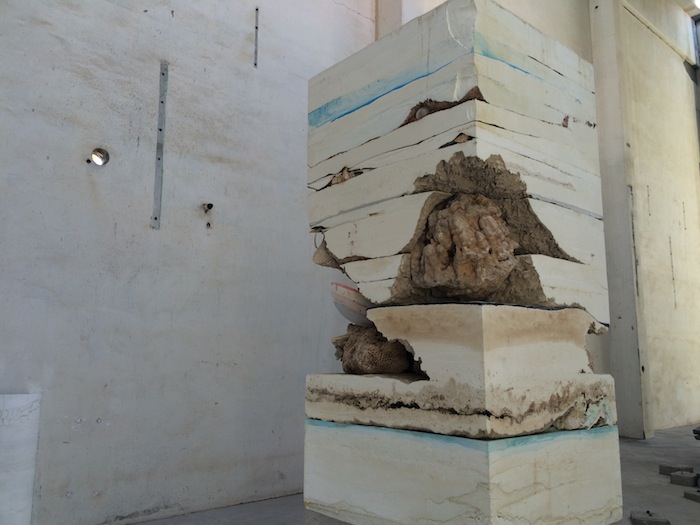
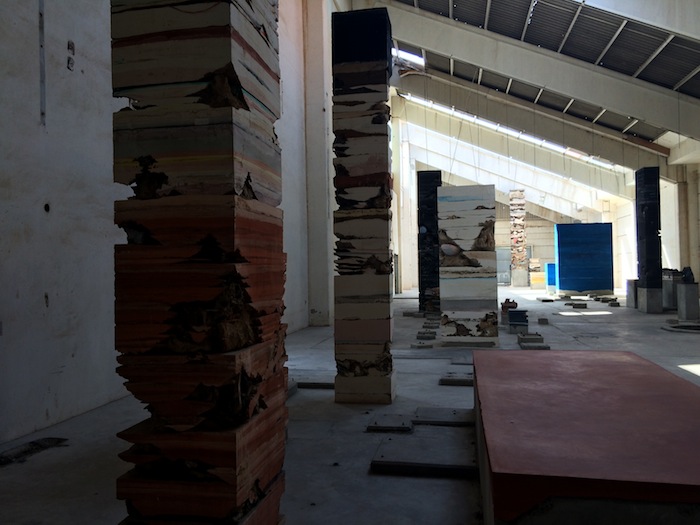
Adrian Villar Rojas - Planetarium © Hind Mezaina
This was the piece everyone was talking about during the biennial. It was located an hour's drive away from Sharjah and the biennial, in a former ice factory located at the creek (khor) in the southern area of Kalba - Khor Kalba.
To me, this piece encapsulated the "The past, the present, the possible" and had to be seen in person to really appreciate the magnitude and the details in it.
The practice of Adrián Villar Rojas is marked by large-scale, site-specific interventions that incorporate his fascinations with battling ecosystems, physical decay, unlikely rebirth and man’s interference in it all.
Continuing his recent experiments with organic matter, colour, suspension and cultivation, Villar Rojas has stationed his team of carpenters, metal workers and artists in an abandoned ice factory in the east-coast city of Kalba for two months to develop a massive installation of new works.
Extrapolating on cement protrusions, trenches and pits left behind at the site, the team introduced vast amounts of construction materials and a range of plants, shells, rocks, trash and bones collected in the UAE to cover the 2,400-square-metre space with a balanced composition.
Mimicking a filtration-system he witnessed in the Sharjah Municipality’s composting plant, Villar Rojas has also deployed tons of freshly produced compost to frame the main plaza of this obsolete factory.
An anomalous substance in the region, such enriched soil demonstrates how increased consumption and demographic expansion can be transformed into living parts of the environment.
Watch this video interview with Adrian Villar Rojas talking about the work and explaining the process behind it.
